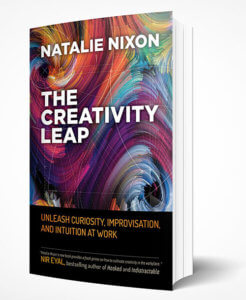
“Leaps of creativity,” Natalie Nixon writes in The Creativity Leap: Unleash Curiosity, Improvisation, and Intuition at Work, “are the only way to solve the complex problems and to innovate for the future.” (Sahar Coston-Hardy)
When I talked three years ago to creativity strategist Natalie Nixon, president at Figure 8 Thinking, she struck me as one of the most original thinkers I’ve ever interviewed. Nixon, who spoke at Convening Leaders 2018 about innovating through improvisation, developed her expertise in strategic design following a multi-disciplinary path, earning degrees in anthropology, African studies, and textile studies, and a Ph.D. in design management.
When I went back to reread that interview in the Convene archives, I discovered that Nixon had been even more insightful than I remembered. I’d asked Nixon, a global keynote speaker on topics including the future of work, about what she saw ahead for meetings. In response, Nixon zeroed in on the ways is which technology was both disrupting businesses and enabling people to meet online in much more creative ways. “What I’m waiting for,” Nixon said, “is technology that can help us to truly be more interactive in the digital space. Right now, what we have are abilities to see each other and hear each other, and there are wonderful platforms like Mural that enable you to brainstorm collectively online. I foresee there’ll be a lot more of those.”
With the publication of The Creativity Leap: Unleash Curiosity, Improvisation, and Intuition at Work, Nixon seems once again to be ahead of the curve. The book, which came out in June, was written before the pandemic, but was addressed to a world filled with complexity and disruption. “Leaps of creativity,” Nixon writes, “are the only way to solve the complex problems and to innovate for the future.”

In her book, Natalie Nixon lists three tactical routes to creativity,
All humans are hard-wired to be creative, but learning how to exercise creativity is a competency, according to Nixon. Her definition of creativity is the ability to toggle between two different capacities — wonder and rigor. Wonder is the ability to be awed and “ask big audacious questions,” Nixon writes, and rigor is the realm of “discipline, practice, skill, and honing your technique by spending lots of time on tasks.” Creativity requires analytical rigor, according to Nixon, “and analysis requires a capacity for wonder.”
It may seem counterintuitive to think about wonder in times like these, she wrote in a column published in Technical.ly. “I know it may feel more important to dig in your heels during times of crisis and only focus on the practical, survival mode stuff. And you’re right. Creativity is incredibly practical and is crucial to survival. It is not a luxury reserved for days of repose.”
In her book, Nixon lists three tactical routes to creativity:
Inquiry. Inquiry triggers the leap that bridges the gap between what you know and what you currently don’t understand. “It is the practice of honing your ability to frame and reframe questions, to use questions as a way of thinking through and processing,” she writes. One of her inspirations is the model built by Warren Berger, author of A More Beautiful Question.
Improvisation. Improvising, Nixon writes, “is about building on ideas within minimal constraints” — it allows for “the freedom to experiment within rules and fluid structures.” Nixon has integrated lessons learned from jazz into her work, including embracing errors and alternating between playing leading and supporting roles.
Intuition. We all have a “visceral, internal wisdom that allows for unconscious pattern recognition and insights for decision-making,” Nixon writes. Harriet Tubman, Steve Jobs, and Albert Einstein are three famous innovators who famously coupled their intuition with their rational intellect to make decisions.
The Creativity Leap includes exercises to help readers and organizations develop their own creative competencies. For example: “Become a clumsy student of something.” Cultivate a new hobby, and marvel at how good you become at asking questions, improvising, building on mistakes, and intuiting.
Barbara Palmer is deputy editor of Convene.
